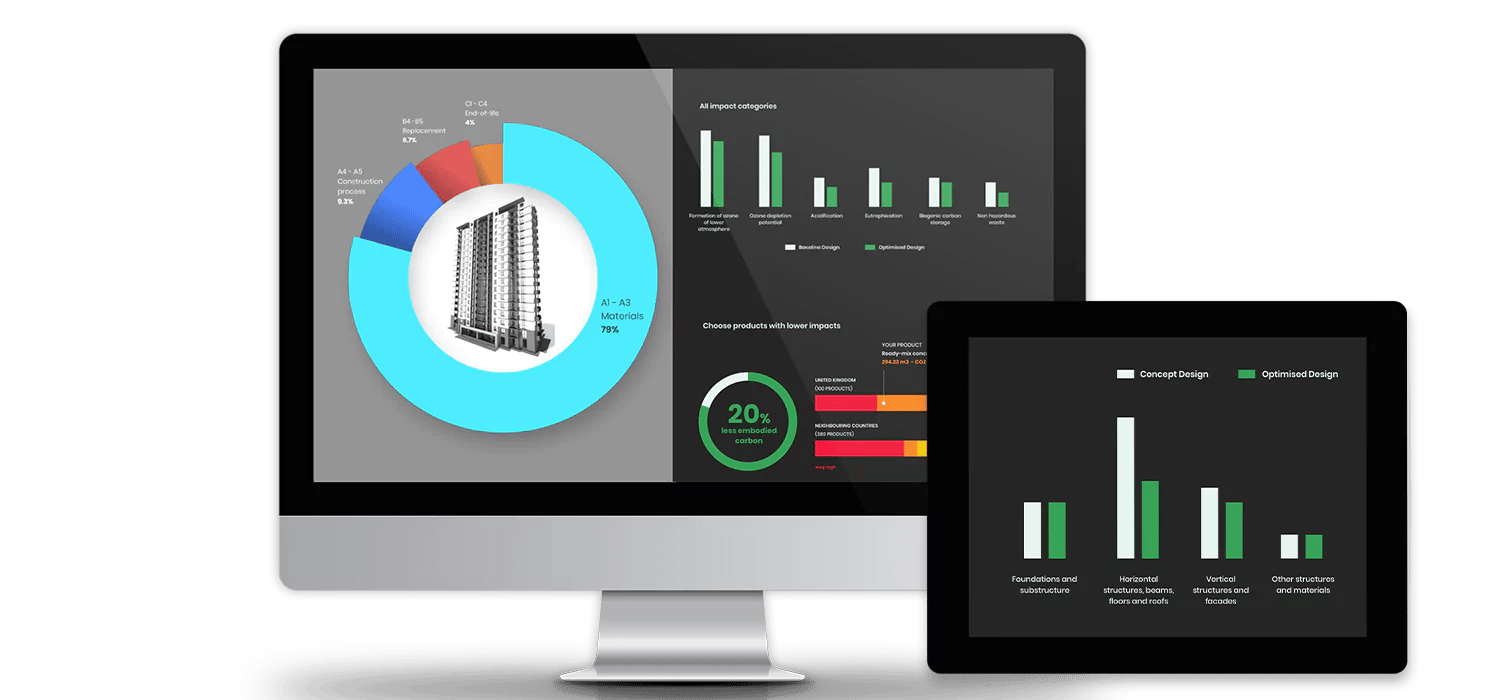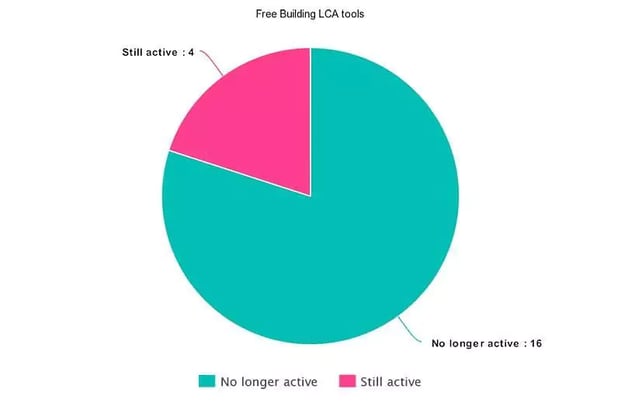
A brief history of free LCA construction tools
The European Commission responsible for Level(s), the new EU framework for sustainable buildings, published a list of life-cycle assessment (LCA) tools that can be used for Level(s). You can find that list here. While browsing it, one thing immediately became evident: most of the free tools listed in the document have long ceased to be active. Of the free tools listed, 80% have ceased operations or have not been updated in years.

Another example comes from the 2009’s list of life-cycle assessment tools in the article “Life-cycle assessment in buildings: State-of-the-art and simplified LCA methodology as a complement for building certification” by Zabalza Bribián, Usón and Scarpellini. Out of 14 tools, only 5 are still operational, and only one of those is a free tool, last updated in 2012.
Why do LCA construction tools exist?
Before looking into why so few free tools survive, we should understand why they exist. The rise of free LCA construction tools is a response to the increased interest in building sustainability and how to achieve it better. Buildings are responsible for 40% of global carbon emissions and affect the environment throughout their entire existence. The construction industry also relies on materials like concrete, whose production can be very intensive in terms of waste production and water pollution. The demand for a clear, objective way to measure the carbon footprint and other environmental impacts of buildings worldwide has led to increased adoption of scientific methodologies applied to the built environment, like Life Cycle Assessment.
LCA construction is the most reliable way to assess how sustainable a building is and what should be changed in order to achieve lower environmental impacts. The introduction of more stringent regulations that require clear and actionable metrics and a market increasingly concerned with the future of the planet have led to a renewed focus on sustainability in the construction industry. As a result, many governmental bodies, academic institutions, and private bodies have invested in developing tools to calculate the environmental impacts of buildings.
Why do free LCA construction tools die?
“Although a number of commercial and non-commercial organizations are developing in-house tools to calculate embodied carbon, these lack the flexibility to be adopted by a wide range of users as well as the efficiency required to be appealing to designers at the early stages of a design.”
Chamindika I. Ariyaratnea, Dr. Alice M. Moncasterb. “Stand-alone calculation tools are not the answer to embodied carbon assessment”. 6th International Conference on Sustainability in Energy and Buildings, 2014. Free LCA construction tools are born easily, but keeping them alive has proven much more difficult. Some of the reasons behind their premature demise can be explained as “free software syndrome”: lack of time and resources to keep the software updated and running, new regulations making the software obsolete, outdated websites, and in general all the common downfalls associated with free tools. However, some reasons are specific to buildings and Building Life Cycle Assessment software. When it comes to calculating the environmental impacts of a building accuracy of results and availability of data become essential. These are the main problems you might encounter when trying to assess the environmental impact of a building:
- the complexity of calculations
- the need to provide reliable results
- the difficulty to access and use the data you need for the calculations
This reflects one of the difficulties that most free LCA tools encounter, which is the lack of a database, or availability only of a limited amount of local data. Another one is the fact that the person doing the calculations might have access to data in a format that is not compatible with the software, for example in a Revit model, and that exporting and using that data within the software requires a lot of manual work. Moreover, most free tools cannot provide compliant results for Green Building certification schemes, and can be quite complex to use. In their 2016 article “Environmental footprint assessment of building structures: A comparative study”, Sinha, Lennartsson, and Frostell analyzed the attempt of the City of Stockholm to promote the use of the Excel-based tool, ELP, and pointed out how many users found it too complicated for their purposes (spoiler alert: currently, ELP seems to have disappeared as well). To summarize, free life-cycle assessment tools often fail because they don’t adequately respond to the needs of the people who should do LCA, and because they aren’t updated due to lack of resources
How to choose a LCA construction software?
If you are looking for a Building LCA tool, there are a few things you should keep in mind in order to select the best option for your needs.
- Quality: quality can be assessed via third-party verifications
- Applicability: does the software support your desired certifications and integrate the data you need?
- Versatility: customizability for specific purposes and availability of additional tools
Why you should include One Click LCA in your comparison
Let’s clarify: we don’t think there is no place for free Building Life Cycle Assessment tools on the market. On the contrary, the development of free tools by research institutions, governments, and municipalities will hopefully contribute to wider adoption of the principles of Life Cycle Assessment. We strongly believe that is essential to continue raising awareness regarding sustainability in the built environment, and that Life Cycle Assessment is the best methodology to reduce carbon emissions of buildings worldwide. That said, we also encourage you to include One Click LCA in your comparison of Building LCA tools.
One Click LCA is a Building Life Cycle Assessment software that automates the Life Cycle Assessment process and allows you to calculate the carbon footprint and other environmental impacts of your buildings much faster than usual, thanks to automated data import. We also have the biggest LCA database of building materials on the market, and tools for EPD, CSR, Infrastructure, Life Cycle Costing, and more. The step-by-step Navigator for One Click LCA within IES Virtual Environment (IESVE) provides seamless automation, makes undertaking LCA and LCC easier than ever, and replaces the previous IES IMPACT Suite. We also offer free licenses for students and coursework.
A short overview of One Click LCA
| Quality | |
| 3rd party certified | yes (for both ISO and EN standards) |
| BREEAM LCA rating | 100% (certified by BRE) |
| Productivity | |
| Deployment | Cloud |
| Time for LCA | Less than a day |
| Ease of use | 4.5/5 based on customer reviews. Read them here. |
| Applicability | |
| Certifications | + 80 including BREEAM, LEED, DGNB, HQE, etc. |
| Integrated EPDs | + 8000 |
| LCA databases | + 30 including Oekobau, IMPACT, Ecoinvent, etc. |
| Versatility | |
| Customizability | yes |
| Additional tools | LCC, CSR, EPD, Infrastructure, and more |
| Integrations | Revit, IESVE, BIM, ArchiCAD, gbXML, Tekla Structures, DesignBuilder, Excel |
| Credits | |
| BREEAM | up to 24 (UK) and 19 (Intl) |
| LEED | 8 + regional |
Want to know more?
Carbon Experts Newsletter
Industry news & insights — straight to your inbox
Want to learn more?
Asha Ramachandran • Feb 14 2024
Billy Lusk • Jul 03 2024
Asha Ramachandran • Feb 08 2024
Panu Pasanen • Feb 13 2024
